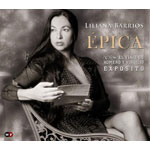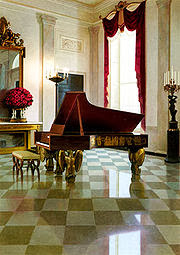In review--Amor-ica Musica!
Èpica (El Viaje de Homero y Virgilio Expòsito)
My mother claims that she played all types of music to my siblings and me when we were babies. She mentions that she even played “highbrow music” and most likely she was referring to European classical, but she might have meant Argentine tangos and Cuban son, after all, my mother grew up in Panama and her first language is Spanish.
However, my first language is not Spanish and it certainly isn’t the language of tango or son, but this music is probably floating in my DNA somewhere among those Spanish peasant genes. Certainly when I hear a bandoneon conversing with weeping strings passion and pathos bubble over in my bloodstream; my heartbeat quickens.
It’s not fair to Argentine tango musicians, but when someone mentions tango my mind automatically thinks of Astor Piazzolla. Tango has its lineage of vocalists, bandoneon players and composers. Some of the younger ones draw upon other Argentine and South American musical influences in their work. Vocalists Sandra Luna and Liliana Barrios interpret older work and both of those women delve into macho territory in which they give a feminine makeover.
On Èpica, Liliana Barrios maps her way through tango, bolero, milonga, and candombe with text by the Expòsito Brothers. But with the strains of the bandoneon and violins this sounds like a collection of pan-American tangos with the exception of the candombe piece Azabache which sports Afro-Latin rhythms played on traditional percussion. That particular song would feel at home on an album by Argentine Chango Spasiuk.
While I don’t have English translations of the lyrics, the Barrios’ vocals convey regret, despair and deep longing. Her smoky alto voice slides around the piano, violins and bandoneon as she takes command. She delivers the melancholic sentiments like the letter she holds on the album cover. She enters a macho tradition and proves she’s not a pushover. Listen to her heartfelt delivery on Fangal or her lively vocals on the opener El Entrerriano, where they frolic with spritely violin, woodwinds and piano.
From the darker tones of Buenos Aries to the sun-dripping soñes of Cuba, we’re still dealing with machismo, but at least the music provides a few enjoyable moments. Formed in the mid-1970s by university students, Sierra Maestro keeps the Cuban son tradition alive on their acoustic album Sonando Ya. Most of the songs reflect romantic love, though the musicians pay homage to Yoruba gods on Un Toque de Bembè and on the opening track, Pal ‘Monte, the singer reminds himself of his rustic roots.
With so many Cuban musical genres to confuse listeners Sierra Maestro brings us the rustic son, a musical style said to have been born in the mountains of Eastern Cuba. Anyone who has heard the Buena Vista Social Club or Cubanismo knows the son well. Featuring the characteristic three double-stringed guitar très, acoustic guitars, horns and percussive cross rhythms that gravitate around the clavè beat (1-2-3-1,2). Rapid call and response vocals top it off infectious melodies. Also in this musical tradition, vocalists improvise vocal phrases on the spot about love, romance or politics. Remember the Carnegie Hall concert footage in the documentary Buena Vista Social Club when the lead singer goes to town singing rapid text?
Sierra Maestro pays homage to Cuban classics from the Golden Age (1940s and 50s), but the songs sport more contemporary lyrics without any sexist references. The song A una mujer celebrates the singer’s mother. “From you I received love immeasurable. From your tree I am your flower…” croons Luìs Barzàga. And on the song, Estado de ànimo the text describes the protagonist as blank paper that his lover writes their fate. Cuban son and trova songs offer both lively music arrangements and poetic text. Sierra Maestro’s recording provides the right Cuban flavors, sizzling arrangements and sensual vocals.
Depending on your mood and the occasion, you can explore Latin Amor-ica music through Cuban son or Argentine tango. (That’s just the tip of a large iceberg). And in the process learn geography, history, culture and brush up your Spanish language skills. Soon you’ll be speaking tango and son too.
I dedicate this highbrow music to my mother.
http://www.worldvillagemusic.com/
World Village
Sierra Maestra
Sonando Ya
World Village
However, my first language is not Spanish and it certainly isn’t the language of tango or son, but this music is probably floating in my DNA somewhere among those Spanish peasant genes. Certainly when I hear a bandoneon conversing with weeping strings passion and pathos bubble over in my bloodstream; my heartbeat quickens.
It’s not fair to Argentine tango musicians, but when someone mentions tango my mind automatically thinks of Astor Piazzolla. Tango has its lineage of vocalists, bandoneon players and composers. Some of the younger ones draw upon other Argentine and South American musical influences in their work. Vocalists Sandra Luna and Liliana Barrios interpret older work and both of those women delve into macho territory in which they give a feminine makeover.
On Èpica, Liliana Barrios maps her way through tango, bolero, milonga, and candombe with text by the Expòsito Brothers. But with the strains of the bandoneon and violins this sounds like a collection of pan-American tangos with the exception of the candombe piece Azabache which sports Afro-Latin rhythms played on traditional percussion. That particular song would feel at home on an album by Argentine Chango Spasiuk.
While I don’t have English translations of the lyrics, the Barrios’ vocals convey regret, despair and deep longing. Her smoky alto voice slides around the piano, violins and bandoneon as she takes command. She delivers the melancholic sentiments like the letter she holds on the album cover. She enters a macho tradition and proves she’s not a pushover. Listen to her heartfelt delivery on Fangal or her lively vocals on the opener El Entrerriano, where they frolic with spritely violin, woodwinds and piano.
With so many Cuban musical genres to confuse listeners Sierra Maestro brings us the rustic son, a musical style said to have been born in the mountains of Eastern Cuba. Anyone who has heard the Buena Vista Social Club or Cubanismo knows the son well. Featuring the characteristic three double-stringed guitar très, acoustic guitars, horns and percussive cross rhythms that gravitate around the clavè beat (1-2-3-1,2). Rapid call and response vocals top it off infectious melodies. Also in this musical tradition, vocalists improvise vocal phrases on the spot about love, romance or politics. Remember the Carnegie Hall concert footage in the documentary Buena Vista Social Club when the lead singer goes to town singing rapid text?
Sierra Maestro pays homage to Cuban classics from the Golden Age (1940s and 50s), but the songs sport more contemporary lyrics without any sexist references. The song A una mujer celebrates the singer’s mother. “From you I received love immeasurable. From your tree I am your flower…” croons Luìs Barzàga. And on the song, Estado de ànimo the text describes the protagonist as blank paper that his lover writes their fate. Cuban son and trova songs offer both lively music arrangements and poetic text. Sierra Maestro’s recording provides the right Cuban flavors, sizzling arrangements and sensual vocals.
Depending on your mood and the occasion, you can explore Latin Amor-ica music through Cuban son or Argentine tango. (That’s just the tip of a large iceberg). And in the process learn geography, history, culture and brush up your Spanish language skills. Soon you’ll be speaking tango and son too.
I dedicate this highbrow music to my mother.
http://www.worldvillagemusic.com/





Comments
Post a Comment